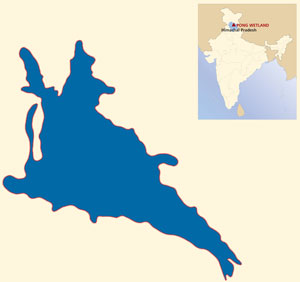| |
|
| |
|
|
|
| |
 |
| |
|
| |
|
| |
Background |
| |
|
| |
The Pong wetland, also called Maharana Pratap Sagar, one of the largest manmade wetland of Northern India, was formed with the construction of a dam across the Beas River in 1975 and is located in district Kangra in Himachal Pradesh. The area of the wetland is 307 sq.kms and the catchment is 12,650 km2. The catchment area mainly comprises of agricultural land. The Bhakra Beas Management Board (BBMB), which undertook the construction of Pong dam, has acquired 28,000 hac of land in the catchment of Pong dam wetland. The dam resulted in the formation of a huge reservoir. The length of the reservoir is 41 km with a maximum width of 19 km. The environs of the Pong Dam Lake support good bird diversity. It hosts more than 220 bird species. The lake harbours 27 fish species, which depend on it for food, spawning ground and nursery. Around 95,000 birds, both migratory and local, are roosting and feeding in the Pong Dam area.
In 1994, the Ministry of Environment and Forests, Government of India declared it a “Wetland of National Importance”. Pong Dam Lake has been declared as Ramsar Site in November 2002. All land up to 440mts in the catchment of the wetland was notified as buffer zone. The Pong Dam Wildlife Sanctuary, spread over about 300 sq km and home to hundreds of birds and animals, is facing a threat from encroachment by the local farmers. The fields around the Pong Dam are being used to poison migratory birds. The birds feed in the fields or the areas around the wetlands at night. This damages crops in the encroached fields. The farmers in order to save their crops or to hunt them put poisonous seeds in the fields. The birds die after consuming the poisoned seeds and farmers remove the dead birds to escape the wrath of the wildlife authorities.
Encroachments around the wetland area pose much greater threat to the ecology of the area. Pesticides and other toxic wastes generated in the fields go directly into the wetland, adversely affecting the ecology. The most serious threat comes from agriculture and forestry malpractices in the water catchment area.
In 1983,the entire reservoir was declared as a Wildlife Sanctuary by the Himachal Pradesh government. A management plan was prepared in November 1982 and approved in December 1984, for protection of the sanctuary. The State forest department has undertaken plantation work in the peripheral area of the lake. This has been done for checking the silt as well as providing nesting and roosting places for the birds. The island of Ramsar has been developed for nature conservation education, complete with rest house and boat facility.
|
| |
|
|
| |
 |
|
| |
|
|
| |
|
|
| |
Links |
|
|
| |
| |
Research paper:
Geochemistry of Renuka Lake and wetland sediments, Lesser Himalaya (India):
Implications for source-area weathering, provenance
Environmental Geology, Issue Volume 54, Number 1 / March, 2008
Read more...
Information Sheet on Ramsar Wetlands (RIS)
Bibliography:
Renuka wetland: a newfound abode for migratory birds in Himachal pradesh, Mohan, L. Sharma, R. M. Tak, P. C. , 2005, VOL 131; NUMB 2, pages 163-169.
Book:
Fauna of Renuka Wetland (Himachal Pradesh); 2000; The Director, Zoological Survey of India (ed); 187 p.
|
|
|
|
|
| |
|
|
|
| |
 |
|
|
| |
|
|
|
| |
PEOPLE |
|
|
| |
Government:
State Council for Science, Technology & Environment (H.P)
HP B-34 SDA Complex Kasumpti
Shimla-171009 HP India
Phone: 91-177-2622489, 2622490
Tele Fax: 91-177-2620998
Researchers:
Brijraj K. Das and Parkash Kaur
Centre of Advanced Study in Geology,
Panjab University,
Chandigarh, 160014, India
Birgit Gaye
Institute of Biogeochemistry and Marine Chemistry,
University of Hamburg,
Bundesstrasse 55, 20146
Hamburg, Germany |
|
|
| |
 |
|
|
| |
|
|
|
|